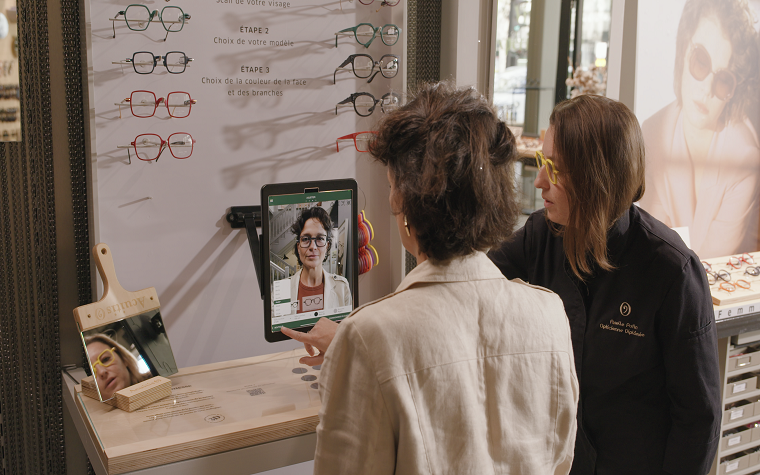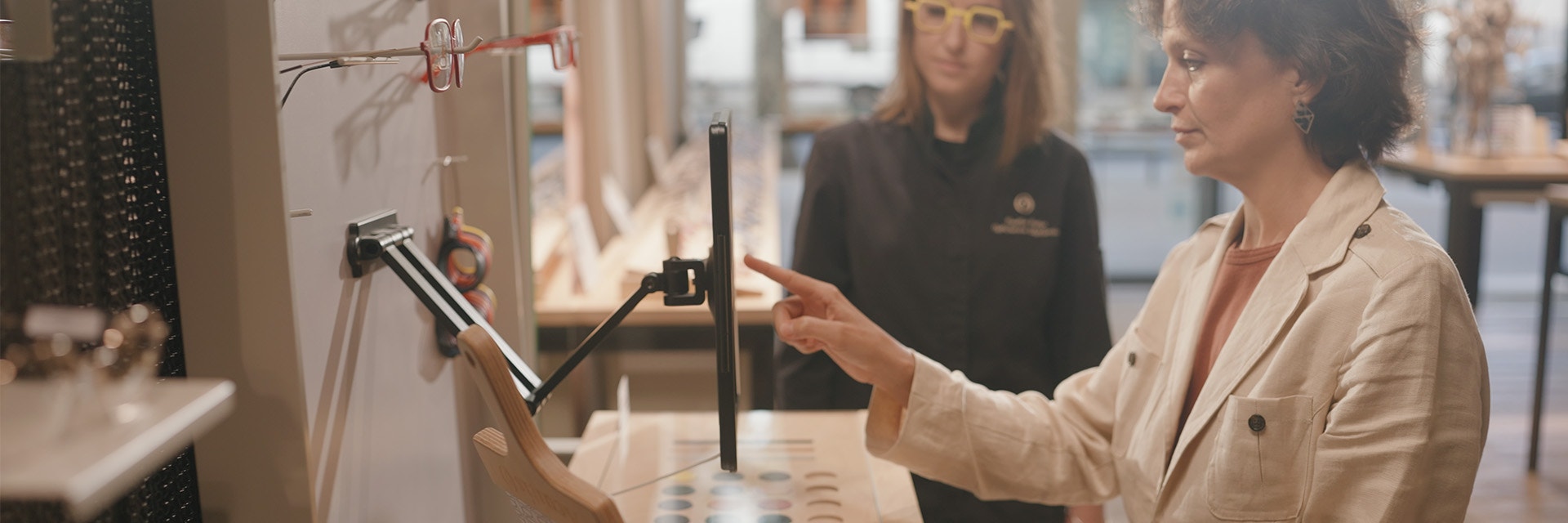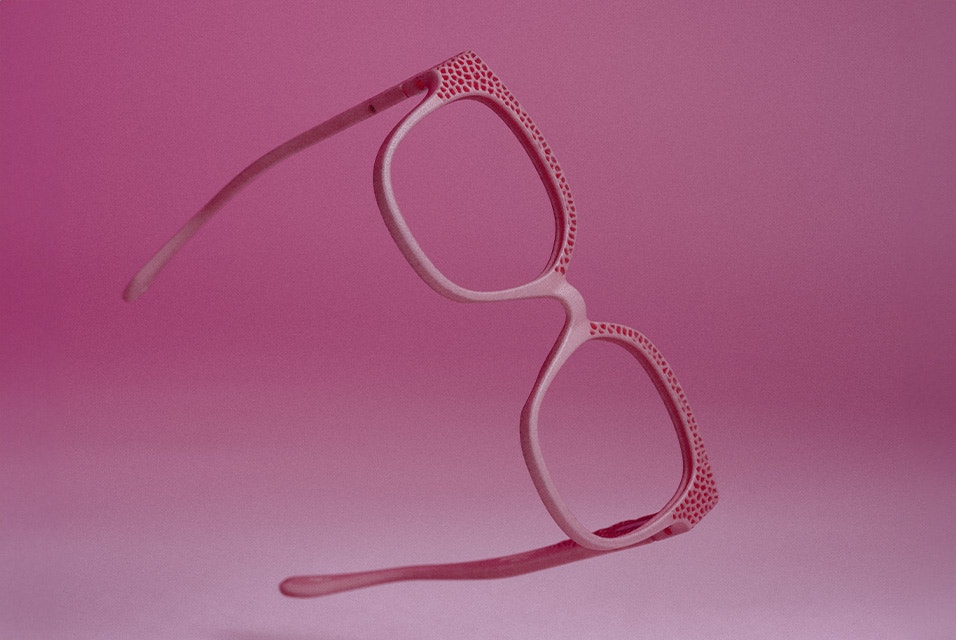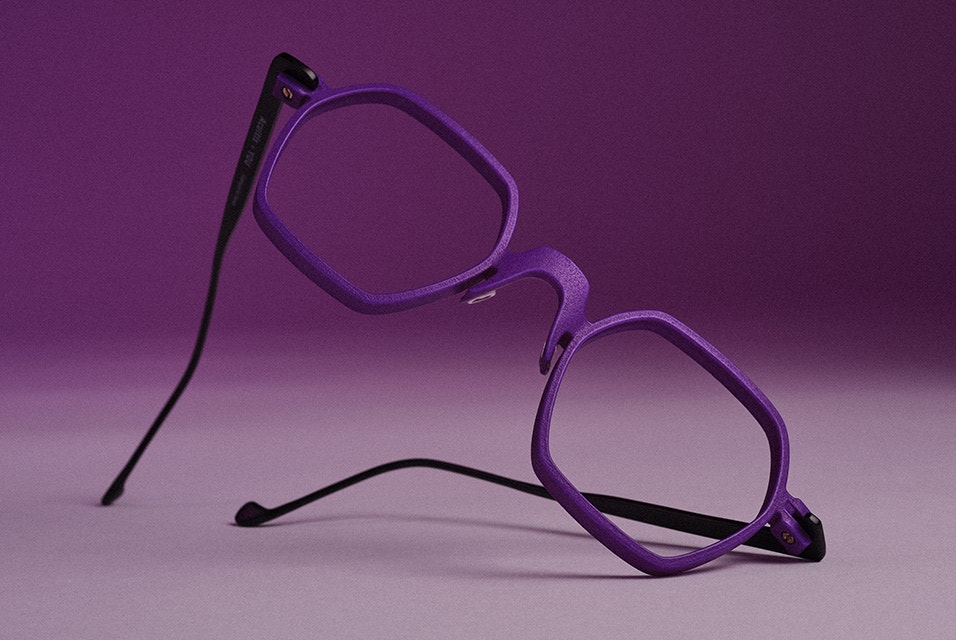CUSTOMER STORY
Acuitis Goes Digital: The Joys of “Simplexity” and Eyewear’s Endless Opportunities

Acuitis — a leading French eyewear boutique — took a major step towards digitalizing their customer journey when more than 100 stores adopted the Materialise Eyewear Fitting Suite, bringing new levels of personalization to their service.
When Frederic Beausoleil, Artistic Director at Acuitis and an eyewear designer for over 30 years, first experienced the Eyewear Fitting Suite, he described it in a single word.
"Simplexity."
The tool is easy for retailers to learn and use. The customer experience is fast and smooth. On the surface, it's remarkably simple: an in-store optician begins each consultation by capturing a 3D scan of the customer’s face. Using 3D rendering software, they can then guide their guest through true-to-life digital twins of the available frames, with suggestions based on their physical data.
So simple, perhaps, that it's easy to ignore the complexity behind it. A powerful algorithm, based on years of research in Materialise's medical segment and tailored to the eyewear industry, builds each face on screen using over 10 million cloud points. It ensures that every reconstruction is true to life — as are the digitalized frames that enable on-demand customization.
It turns every store into a data collection unit and helps retailers create a comfortable, more personal environment.
But that’s just touching on the true potential of a tool with the power to change an industry.
Empowering inclusivity
“We were impressed with the Eyewear Fitting Suite as it provides more than just an app with virtual try-on features,” says Guénola Giangrasso, Director of Marketing and Communication at Acuitis. “It also offers sizing recommendations. I don’t just try out a frame — the frame sits perfectly on my face because its measurements are determined by the shape and size of my face and my pupillary distance.”
On the surface, the benefits are obvious: each customer gets a more customized solution, resulting in a better fit. But for Acuitis, it’s the broader implications of this personalization that really stand out.
“It’s crucial to acknowledge its full potential: ensuring inclusivity is of utmost importance and cannot be overlooked,” Guénola tells us. “This solution truly enables us to adjust to all kinds of customers, with all different face shapes.”


A new customer journey
Understandably, offering a new, increasingly personal service has had a positive impact on the customer experience — and it does so while maintaining the essential human relationship between the Acuitis team and their guests. The scan is a welcome addition to their toolbox; a bridge rather than a barrier.
“The impact on the customer experience is bound to be positive because the 3D experience is truly in line with our DNA as eyewear designers,” explains Laurent Payen, Coach du Réseau at Acuitis. “As soon as our guests experience it, they smile. At first, they were astonished, a little curious, then quickly got the hang of it. It’s a world of co-creation. They can choose their shape and color, the color of the temples, more classic or more creative models. And that aspect is a real plus in recommending our frames.”
A closer relationship
For Acuitis, their in-store team has always been the most important element of the customer journey. If anything, the tool has created an even more positive shift in the dynamic between guest and retailer — a stronger relationship with greater cooperation between the two.
“The system enables our opticians to go further, to learn more about their guests’ motivations faster, more easily, and in greater depth,” says Laurent. “It also leads to a much closer relationship — it’s sincere and much more transparent.”
That transparency is largely based on the nature of the tool. With AI determining the ideal size for each wearer, it brings a dose of objectivity and impartiality to the entire process — something that Laurent says is a relief to his customers. Questions about which size to choose have always been frequent.
“What’s interesting is that on the tablet, they can choose three, four, or five different models and try them out smoothly and easily. Our guests love it,” he continues. “On top of that, it helps our ambassadors to encourage them to try new frames or styles that they wouldn’t have gone to naturally, taking them out of their stylistic comfort zone. That’s a real interest for an eyewear designer like Acuitis because it’s kind of our vocation, in a way.”
The importance of people
Clearly, the customers are eager to try the new solution — but its success would never have been possible if the Eyewear Fitting Suite was a burden for the opticians who use it. Getting their buy-in was essential.
“Quite honestly, using the platform is extremely easy, smooth, and almost intuitive,” Laurent tells us. “In other words, training our teams to use the tablet went very quickly. We focused more on ways of creating desire with our customers, inviting them to join us on the adventure and try the 3D experience. Once they’ve experienced it, our customers become the best promoters for 3D, but no matter how good it is in-store, it will never replace the optician’s support for their guest.”


A blessing for the bottom line
The Eyewear Fitting Suite is clearly popular with both customers and opticians, but how has it affected Acuitis as a company? As in any industry, a new solution needs to offer an ROI , and so far, the outlook is certainly positive.
“It’s had an impact on the way we work — both our marketing and distribution networks. But it’s mainly about marketing and communication because we’ve invested heavily in communicating this new customer experience,” explains Guénola. “And it’s working because it’s bringing people into the boutiques.”
Importantly, this marketing — ranging from a televised advertisement to a billboard — does more than bring in tourists. Interest is quickly turning into sales.
“Word of mouth has had a real impact,” she continues. “People came to our stores to see how the app works. 50% of them actually bought a 3D-printed frame. The rest came to get to know the brand and may have bought something else. There is a real and very strong power of attraction.”
Customers are happy. Customers are buying. And customers are spreading the word. The end result is an increased basket value, though, as Laurent explains, that is not unexpected given the nature of 3D-printed eyewear.
“3D collections tend to be positioned at the top end of the market, but what’s interesting is that none of our customers have concerns about value for money,” he tells us. “In other words, once they’ve had the experience and understood that we are going to make glasses to truly fit them, they have absolutely no objection to the price. They’re more open to buying simply because living an experience that is playful, co-creative, and where they can really participate in designing the final frame helps them fall in love with the result.”
A virtual inventory in a digital future
Crucially, as Guénola mentioned, the Eyewear Fitting Suite has impacted more than marketing or the company’s bottom line. It holds the potential to change the way Acuitis manages its entire inventory — and it’s a possibility the company is strongly considering.
“In the long run, the system could allow us to completely dematerialize the collection,” she says. “Today, we have products available for purchase in-store, but in the future, we can dream of having a completely virtual stock.”
Completing the value chain
With solutions like the Eyewear Fitting Suite beginning to prove their worth in retail, it’s important to also take a step back and remember their impact outside of it — beginning particularly with eyewear designers. The benefits of adopting digital tools are felt throughout the value chain.
“3D printing enables the development and design of just about everything. In that, it’s wonderful. Above all, it enables the development and product design that would be unimaginable in traditional manufacturing,” says Frederic. “It allows you to play with all your inspirations.”
These inspirations — and the design freedom afforded to him — led to the 3D collection found in Acuitis boutiques. Featuring a trio of distinct yet complementary styles, it moves from a classic, Nordic theme through iconic shapes with a modern twist and ends with something very structural. It's a blend of modernism and avante-garde that only 3D printing could offer.
More important to Frederic, however, is how he and his fellow designers can use these technologies to meet the needs of those who wear his frames. When combined with innovations like digital twins, it has the potential to create a landmark moment in the eyewear industry.
“Today, personalization is a huge trend in many industries. There is a very strong emerging demand for this. Being able to offer made-to-measure frames responds to this demand: choose your shape, choose your color, choose your size. It’s a real innovation and an undeniable plus for our guests,” he tells us.
“Digital twins were invented through medicine — but optically, we’re the leaders, and we know how to capture this major innovation. It’s an extremely rare offer in retail — a totally disruptive offer. It’s amazing to see how people are completely blown away. To have their faces scanned and have this digital twin; to discover their fully digitalized face and put a frame on it, is a truly unique experience.”
What comes next?
For Acuitis now, the big question is, what comes next? Has the system made a lasting impression? As far as Guénola is concerned, the answer is a resounding yes.
“We have a lot of future plans,” she tells us. “It could be new shapes, new materials, or new colors. That’s another area where we’re looking to Materialise for proposals and innovations. But in any case, we know that the range of possibilities is just extraordinary.”
All images courtesy of Acuitis
Share on:
You might also like
Never miss a story like this. Get curated content delivered straight to your inbox.





